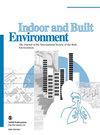不同排风量抽油烟机的性能分析
IF 2.9
3区 工程技术
Q2 CONSTRUCTION & BUILDING TECHNOLOGY
引用次数: 0
摘要
本研究调查了在污染物排放阶段(烹饪时)和污染物衰减阶段(烹饪后),排风量对住宅厨房不同角度抽油烟机去除油烟污染物性能的影响。实验引入了捕获效率、暴露率、衰减率、功率和多指标分析等指标,分析了不同排风量和角度的抽油烟机的性能。实验结果表明,随着烹饪时排风量的增加,捕获效率也随之提高。考虑到抽油烟机的能耗和噪音,抽油烟机的排风量应设定为 600 m3/h 至 800 m3/h。在污染物衰减阶段,PM2.5 质量浓度的衰减率 K 随排风量的增加而增加。烹饪结束后,油烟污染物仍留在厨房中。如果继续开启抽油烟机并设置较大的排风量,室内油烟污染物的浓度可迅速降至标准值以下。我们的研究结果可为住宅厨房抽油烟机的风量调节提供参考。本文章由计算机程序翻译,如有差异,请以英文原文为准。
Performance analysis of range hoods with different exhaust air volumes
This study investigated the effect of exhaust air volumes on the performance of range hoods at different angles in residential kitchens in removing grease pollutants, during the pollutant emission stage (whilst cooking) and the pollutant attenuation stage (after cooking). Experiments were conducted, and introduced indexes such as capture efficiency, exposure rate, attenuation rate, power and multi-indicator analysis were used to analyze the performance of the range hood with different exhaust air volumes and angles. The experimental results showed the capture efficiency was increased with an increase in exhaust air volume whilst cooking. Considering the energy consumption of the range hood and noise, the exhaust air volume of the range hood should be set at 600 m3 /h to 800 m3 /h. In the pollutant attenuation stage, the attenuation rate K of PM2.5 mass concentration was increased with the incremental increase in the exhaust air volume. When cooking was finished, grease pollutants remained in the kitchen. If the range hood continued to be turned on and a large exhaust air volume was set, the concentration of indoor grease pollutants could be quickly reduced to below the standard value. Our findings can provide a reference for the airflow regulation of residential kitchen range hoods.
求助全文
通过发布文献求助,成功后即可免费获取论文全文。
去求助
来源期刊

Indoor and Built Environment
环境科学-工程:环境
CiteScore
6.40
自引率
25.00%
发文量
130
审稿时长
2.6 months
期刊介绍:
Indoor and Built Environment publishes reports on any topic pertaining to the quality of the indoor and built environment, and how these might effect the health, performance, efficiency and comfort of persons living or working there. Topics range from urban infrastructure, design of buildings, and materials used to laboratory studies including building airflow simulations and health effects. This journal is a member of the Committee on Publication Ethics (COPE).
 求助内容:
求助内容: 应助结果提醒方式:
应助结果提醒方式:


